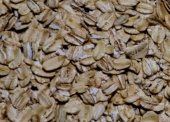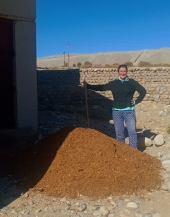


Rolled oats are a type of lightly processed whole-grain food. They are made from oat groats that have been dehusked and steamed, before being rolled into flat flakes under heavy rollers and then stabilized by being lightly toasted. Thick-rolled oats, or old-fashioned oats, usually remain unbroken during processing. Rolled whole oats, without further processing, can be cooked into a porridge and eaten as oatmeal; when the oats are rolled thinner and steam-cooked more in the factory, these thin-rolled oats often become fragmented but they will later absorb water much more easily and cook faster into a porridge; when processed this way are sometimes marketed as "quick" or "instant" oats.

M.K. Dorje Sr. wrote:Hmmm, I'm still perplexed as to what happened. I'm surprised that your kale plants get cabbage worms in the summer, those pests are usually only a problem here in Oregon on cabbages in late spring.

Susan Mené wrote:Does anyone have advice for garlic mustard? I have an abundance. When is the best time to harvest? Can older plants, flowers, and/or seeds be used?



